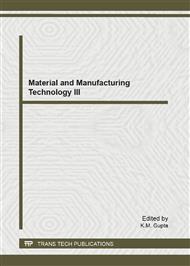[1]
Ki-wook Kim, Sumin Kim, Hyun-Joong Kim, et al. Formaldehyde and TVOC emission behaviors according to finishing treatment with surface materials using 20L chamber and FLEC [J]. Journal of Hazardous Materials, 2010,177: 90-94.
DOI: 10.1016/j.jhazmat.2009.09.060
Google Scholar
[2]
Qian XY. Development of the Chinese wood-based panel industry in the coming five years[J]. China Wood Industry, 2006,20:5-12 [In Chinese].
Google Scholar
[3]
Christophe Yrieix, Alina Dulaurent, Caroline Laffargue, et al. Characterization of VOC and formaldehyde emission from a wood based panel: Results from an inter-laboratory comparison [J]. Chemosphere,2010,79: 414-419.
DOI: 10.1016/j.chemosphere.2010.01.062
Google Scholar
[4]
SHEN Zhe-hong, JIANG Nianchun, CHEN Li, et al. Effects of production factors on formaldehyde emission of E_1 humid resistant medium density fiberboaed[J]. Journal of Zhejiang Forestry College,2005,22(2): 203-206 [In Chinese].
Google Scholar
[5]
Sumin Kim. Environment-friendly adhesives for surface bonding of wood-based flooring using natural tannin to reduce formaldehyde and TVOC emission[J]. Bioresource Technology, 2009, 100: 744-748.
DOI: 10.1016/j.biortech.2008.06.062
Google Scholar
[6]
Chris van Netten,Cliff Shirtliffe,J. Svec. Temperature and Humidity Dependence of Formaldehyde Release from Selected Building Materials[J]. Bull Environmental Contamination and Toxicology. 1989,42:558-565.
DOI: 10.1007/bf01700238
Google Scholar
[7]
Wei Xu, Gao Junlin, Tai Mingqing, et al. Study on the quantitative relationship between formaldehyde released from panel furniture and environmental temperature[J]. Journal of Anhui Agri. Sci., 2009, 37(8): 3651-3653 [In Chinese].
Google Scholar
[8]
WANG Xiao-heng, LIU Xing-rong. Influence of environmental temperature on formaldehyde emission from blockboard[J]. Environ Health, 2008,25(10): 897-899 [In Chinese].
Google Scholar
[9]
FU Bin, SONG Rui-jin. Influence of environmental factors on release quantity of formaldehyde in woodiness boards[J]. Environ Health, 2006,23(5): 436-437[In Chinese].
Google Scholar
[10]
WU Lu-ming, ZHOU Hang. Study on factor for formaldehyde emission of wood-based panels determined[J]. Advanced Measurement, 2006,(4): 28-29
Google Scholar


